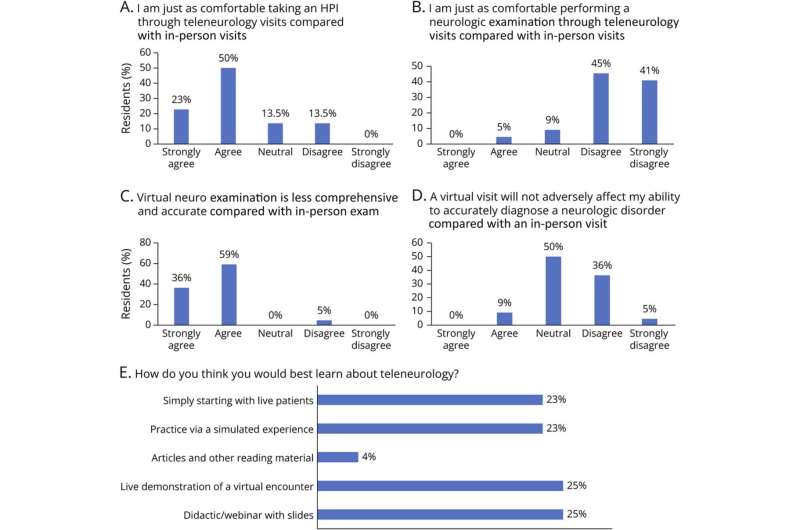This article has been reviewed according to Science X's editorial process and policies. Editors have highlighted the following attributes while ensuring the content's credibility:
fact-checked
trusted source
proofread
Training curriculum addresses teleneurology challenges

A new physician-training system in telehealth simulates key parts of traditional, in-person neurological exams that use little reflex hammers, pinpricks, and flashlights to test nerve function. The three-year program, which was designed by researchers at NYU Grossman School of Medicine, has trained at least 68 neurology residents since its rollout in 2020.
Published online Aug. 3 in Neurology Education, a new analysis of the curriculum identifies challenges to translating in-person exam techniques that use hands-on tools to an online setting, and proposes solutions.
The onset of the coronavirus pandemic in 2020 pushed the medical field toward telemedicine, which enables patients to seek care from their homes using video conferencing, direct messaging on secure smartphone apps, and other electronic platforms. While virtual health care technology has existed in some form for decades, physicians still receive little formal training in its use. According to the authors of the new report, this poses challenges for specialties like neurology that rely on physical interactions and sometimes subtle reactions by patients.
To develop a teleneurology curriculum that overcomes these challenges, the researchers included a range of educational methods such as reading materials, supervised clinical visits, and prerecorded role-play demonstrations performed by faculty members to showcase best practices.
Notably, the course also includes a "simulation" module for trainees to conduct virtual exams on actors trained to mimic the symptoms of meralgia paresthetica, a nerve disorder that causes tingling, numbness, and pain in the outer thigh. In these 10-minute sessions, residents are expected to diagnose their "patients" and discuss a treatment plan. Afterwards, they receive feedback from a faculty member observing the interaction.
"Our curriculum provides much-needed opportunities for future neurologists to hone their telemedicine skills, which will become increasingly important as the field evolves," said study senior author Arielle Kurzweil, MD. "Remote simulation offers a valuable experience for those in parts of the country with limited access to a simulation center and large pool of talented patient-actors like we have here in New York City," added Kurzweil, an associate professor in the Department of Neurology at NYU Langone Health, where she also serves as director of its neurology residency program.
For the new report on the course, the research team surveyed 22 trainees who had received no prior education in virtual care and had no previous experience providing teleneurology visits before undergoing the program. According to the findings, members of the 2020 cohort asked to rate their comfort level with virtual exams improved from an average score of 2.8 out of 5 (5 representing maximum confidence), to 3.8 out of 5 after their first year. Their interest in telehealth grew as well, increasing from an average score of 3.5 out of 5 (5 representing highest interest), to 4.3 out of 5.
The results also showed that residents overwhelmingly preferred active training where they could directly participate compared to more traditional educational methods such as literature, and all first-year trainees rated the curriculum as useful, educational, and worth repeating in the future.
As part of the simulation experience, actors and supervising faculty members grade trainees on their accuracy, thoroughness, and "webside manner." This includes greeting patients after signing in, maintaining eye contact, and displaying open body language, behaviors the authors say can get lost during the shift from live meetings to remote ones.
Residents are also evaluated on how deftly they guide the patient actors through common technical issues, like operating the "unmute function" or adjusting the camera so it captures their face and upper body. In addition, since the trainees cannot provide motor and sensory tests with tools themselves, they must coach patients to perform self-assessments, for example, lightly stroking their limbs with a cold spoon or tissue and describing what they feel.
"This training system demonstrates that a virtual exam requires different techniques from those used in-person," said study co-author Neil Busis, MD, a clinical professor in the Department of Neurology at NYU Langone. "In order to obtain the information they need, neurologists will need to get creative," added Busis, who also serves as director of the telehealth program in neurology at NYU Langone.
Kurzweil notes that the team next plans to add more simulations to the syllabus, including scenarios involving markers of strokes, seizures, and general weakness.
She emphasizes that while teleneurology offers access to health care for those with limited mobility or who may struggle to take time off work or find alternative childcare, it is meant to supplement, not replace in-person visits.
More information: Steve C. Han et al, Curriculum Innovations: A Comprehensive Teleneurology Curriculum for Neurology Trainees, Neurology: Education (2023). DOI: 10.1212/NE9.0000000000200084



















